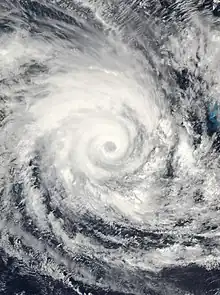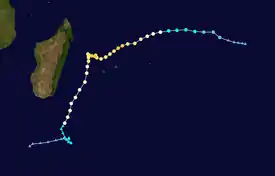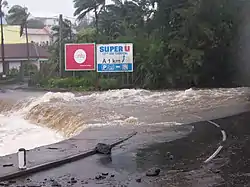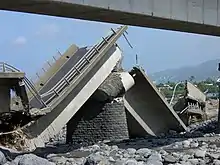Cyclone Gamede
Intense Tropical Cyclone Gamede was among the wettest tropical cyclones on record, dropping more than 5.5 m (18 ft) of rain in a nine-day period on Réunion island in the southwest Indian Ocean. The seventh named storm of the 2006–07 South-West Indian Ocean cyclone season, Gamede[nb 1] formed south of Diego Garcia on February 19 as a tropical disturbance. It tracked generally westward and steadily intensified, reaching tropical cyclone status on February 23. For two days, Gamede stalled northwest of the Mascarene Islands as an intense tropical cyclone, during which it reached 10 minute maximum sustained winds of winds of 165 km/h (105 mph), according to the Météo-France meteorological office in Réunion (MFR).[nb 2] The American-based Joint Typhoon Warning Center (JTWC)[nb 3] estimated peak 1 minute winds of 195 km/h (120 mph), equivalent to a Category 3 on the Saffir–Simpson scale. For four days, Gamede remained within 400 km (250 mi) of Réunion before accelerating southward. On March 2, Gamede transitioned into an extratropical cyclone to the southeast of Madagascar. The MFR tracked the storm for four more days.
 Gamede near peak intensity on February 25 | |
| Meteorological history | |
|---|---|
| Formed | February 20, 2007 |
| Extratropical | March 2, 2007 |
| Dissipated | March 6, 2007 |
| Intense tropical cyclone | |
| 10-minute sustained (MF) | |
| Highest winds | 165 km/h (105 mph) |
| Highest gusts | 230 km/h (145 mph) |
| Lowest pressure | 935 hPa (mbar); 27.61 inHg |
| Category 3-equivalent tropical cyclone | |
| 1-minute sustained (SSHWS/JTWC) | |
| Highest winds | 195 km/h (120 mph) |
| Overall effects | |
| Fatalities | 4 direct |
| Damage | $120 million |
| Areas affected | Mascarene Islands |
| IBTrACS | |
Part of the 2006–07 South-West Indian Ocean cyclone season | |
Cyclone Gamede first passed near St. Brandon, where its 160 km/h (100 mph) wind gusts damaged a few windows. When the storm stalled for a few days, it resulted in a prolonged period of heavy rainfall and high tides for the Mascarene Islands. A pluviometer at Commerson Crater recorded worldwide record rainfall amounts over a period of 3–9 days, with a total of 5,512 mm (217.0 in). Only Cyclone Hyacinthe in 1980 had a higher recorded rainfall total. The deluge from Gamede caused flooding damage across Réunion, washing out a bridge in the southern portion of the island. Monetary damage on Réunion was estimated at over €165 million (US$120 million).[nb 4] Two people each were killed on Réunion and nearby Mauritius. The storm's outer rainbands affected southeastern Madagascar, becoming the fourth tropical cyclone to affect the country in two months. Later, high waves from Gamede flooded coastal portions of the South African province of KwaZulu-Natal.
Meteorological history

Tropical storm (39–73 mph, 63–118 km/h)
Category 1 (74–95 mph, 119–153 km/h)
Category 2 (96–110 mph, 154–177 km/h)
Category 3 (111–129 mph, 178–208 km/h)
Category 4 (130–156 mph, 209–251 km/h)
Category 5 (≥157 mph, ≥252 km/h)
Unknown
The Intertropical Convergence Zone was active across the Indian Ocean in the middle of February 2007, which spawned a low-pressure area southeast of Diego Garcia on February 18.[4] The system developed convection, or thunderstorms, over a weak, but well-defined low-level circulation.[5] The MFR first began tracking the system as a tropical disturbance on February 19.[6] An anticyclone over the nascent system provided weak wind shear and outflow to the north and east, both favorable conditions for development. With a subtropical ridge to its south, the disturbance tracked generally westward for the first few days of its duration.[5] By late on February 20, the system had organized enough for the MFR to upgrade the disturbance to a tropical depression,[6] and for the JTWC to issue a Tropical Cyclone Formation Alert.[3] On the next day, the MFR upgraded the depression to Moderate Tropical Storm Gamede, and the JTWC began issuing advisories on the storm as Tropical Cyclone 15S. At that time, the storm was located about 785 km (488 mi) south-southwest of Diego Garcia, or about 995 km (618 mi) northeast of Rodrigues.[4][3]
As Gamede continued to intensify, its track shifted to the west-southwest.[5] On February 22, the MFR upgraded the system to a severe tropical storm, and the JTWC upgraded Gamede to the equivalent of a minimal hurricane.[6] An eye became evident on satellite imagery, a sign of the storm's development.[7] The MFR upgraded Gamede to tropical cyclone status on February 23, noting that the system was "very broad".[8] Soon after, the cyclone moved over St. Brandon, one of the Outer Islands of Mauritius; the island recorded a minimum barometric pressure of 955 mbar (28.2 inHg), and estimated the eyewall diameter at 50 km (31 mi).[4] On February 24, Gamede passed north of Mauritius and Réunion, approaching within 300 km (190 mi) of the latter island. The storm later slowed and stalled, trapped between the subtropical ridge to the south and a ridge to its northeast. For over 90 hours, the cyclone remained within 400 km (250 mi) of Réunion, resulting in torrential rainfall in the island's mountainous region. During this time, Gamede executed a small loop, and the cyclone attained its peak intensity. The MFR estimated peak 10 minute winds of 165 km/h (105 mph) late on February 25. At the same time, the JTWC estimated peak 1 minute winds of 195 km/h (120 mph).[6][5]
While remaining nearly stationary northwest of the Mascarene Islands, Gamede lost some of its deep convection due to upwelling, the process in which a stationary storm causes the water temperatures to decrease by bringing the cooler, deeper waters to the surface.[5] Early forecasts suggested the possibility that the cyclone would turn westward and strike Madagascar near Toamasina.[9] Instead, a passing trough steered the system to the south-southwest. On February 27, Gamede passed west of Réunion, about halfway between the island and Madagascar.[5] On the next day, the convection near the eye increased slightly.[10] This trend was temporary, as cooler waters and stronger wind shear began affecting Gamede on March 1, leaving the center exposed from the convection. That day, the MFR downgraded Gamede to a severe tropical storm.[11] On March 2, the JTWC discontinued advisories,[3] and the MFR reclassified the storm as an extratropical cyclone. A ridge to its south caused the remnants of Gamede to slow again and execute a small loop southeast of Madagascar. The MFR discontinued advisories on March 4, and the agency tracked the weakening low for two more days at it drifted westward.[5][6]
Preparations

On St. Brandon, the meteorological staff on the island rode out the storm in the Coast Guard office.[4] In Mauritius, a total of 200 people evacuated to storm shelters due to the cyclone.[12] The Mauritius Meteorological Service issued various tropical cyclone warnings for 66 hours, ultimately raising it to a Class IV warning for 6 hours, the highest warning in which gusts of 120 km/h were recorded and expected to continue.[4]
Officials in Réunion closed schools and also issued a temporary driving ban.[13] Due to the threat of the storm, several flights in and out of Mauritius, Réunion, and Rodrigues were canceled.[14] Fishermen were banned from sailing out to sea.[15]
Impact

With its large circulation, Cyclone Gamede's rainbands affected islands in the south-west Indian Ocean for several days. The storm first affected St. Brandon, where its high tides caused severe beach erosion. The cyclone produced wind gusts of over 160 km/h (100 mph), strong enough to damage window panes and part of an anemometer. Rainfall on the island reached 208 mm (8.2 in). Gamede passed south of Agaléga, dropping 99 mm (3.9 in) of rainfall over a four-day period. The storm's rainfall reached 71 mm (2.8 in) on Rodrigues.[4]
Rough waves and strong winds affected a cruise ship to the east of Madagascar; several windows were broken, though no serious injuries were reported.[16] Gamede lashed Madagascar's east coast with squalls of heavy rainfall and gusty winds, affecting areas struck by Tropical Storm Clovis two months earlier.[17][18] Gamede had followed shortly after Tropical Cyclones Bondo, Clovis, and Favio, being the fourth tropical cyclone to impact Madagascar in two months.[19] High waves also struck the South African province of KwaZulu-Natal, forcing the temporary closure of beaches, roads, and the Port of Durban.[20]
Mauritius
Remaining near the Mascarene Islands for several days, Gamede dropped heavy rainfall on Mauritius, reaching 464 mm (18.3 in). Winds on the island reached 158 km/h (98 mph) at Fort Williams in Port Louis.[4]
Gamede killed two on Mauritius,[12] one of whom drowned in high waves.[13] The storm damaged crops and infrastructure, with power knocked out to 70% of the island's population.[12] Despite warnings to remain inside, several people ventured outside during the storm.[21]
Réunion
The large size of the cyclone resulted in several days of very heavy, continuous rainfall in the mountainous region on Réunion island. The heaviest totals occurred from February 24 through February 28,[22] with a nine-day total of 5,512 mm (217.0 in) at Commerson Crater. Several locations on the island reported great totals. In a 24‑hour period, Hell-Bourg reported 1,489 mm (58.6 in), and in a 72-hour period, Cilaos reported 2,321 mm (91.4 in).[22] A peak wind gust of 205 km/h (125 mph) was reported on the island.[13] Gamede produced the highest waves along the north and west coast of Réunion in 50 years, with a maximum wave heights of 11.7 m (38 ft) at Pointe du Gouffre.[23] The prolonged high waves eroded beaches and washed away the promenade at Le Port.[24]
Monetary damage on Réunion from Gamede was at least €165 million (US$120 million).[23] Two people died on the island after attempting to cross rivers during the storm.[25] At least 90 people were injured due to the storm,[24] including two who were seriously injured.[26] The passage of the cyclone left about 100,000 homes without power or water on Réunion.[27][26] High floodwaters damaged a dyke along the north bank of the Rivière des Galets.[24] Gamede caused heavy crop damage, including to the sugar cane and banana crops.[13] Several roads and bridges were damaged on the island.[12] Floods damaged roads in Saint-André and Salazie,[24] and washed out a 520 m (1,710 ft) bridge over the Saint Etienne River, part of Route nationale 1 connecting Saint-Louis and Saint-Pierre.[5][13][28][24] The bridge outage left the two towns temporarily isolated.[29]
Aftermath and records
| Duration (hours) |
Storm name and year |
Record prior to Gamede |
Gamede total | +/- (in mm) | ||
|---|---|---|---|---|---|---|
| mm | in | mm | in | |||
| 24 | Denise (1966)[30] | 1825 | 71.8 | 1625 | 64.0 | -200 |
| 48 | Unnamed (1958) | 2467 | 97.1 | 2463 | 97.0 | -4 |
| 72 | Hyacinthe (1980) | 3240 | 127.6 | 3929 | 154.6 | +689 |
| 96 | Hyacinthe (1980) | 3551 | 139.8 | 4869 | 191.7 | +1318 |
| Total | Hyacinthe (1980) | 5678 | 223.5 | 5512 | 217.0 | -166 |
On June 13, 2007, the government of France provided a relief fund to Réunion of €17.6 million (2007 EUR) in aid, including €9.6 million for farmers affected by the cyclone.[31] The assistance provided €7.7 million for repairing roads and infrastructure, including rebuilding the destroyed bridge over the Saint Etienne River.[31] In the immediate aftermath of the storm, officials deployed army resources to establish a temporary aerial bridge while a new bridge was built.[25] The replacement bridge was opened in June 2013.[28]
Réunion island is the location for several tropical cyclone rainfall records; due to the orography of the island, tropical moisture will travel upward to the volcanic peaks, where it cools and codifies into rainfall.[32] Commerson Crater, located at an elevation of 2.3 km (1.4 mi),[5] recorded historic rainfall accumulations during the passage of Gamede. The location reported 2,463 mm (97.0 in) in 48 hours, which is just short of the worldwide record set by an unnamed tropical cyclone in April 1958. Over 72 hours, Commerson Crater recorded 3,929 mm (154.7 in), which surpassed the previous worldwide record for that duration, set by Cyclone Hyacinthe in 1980. The station also broke rainfall records for precipitation totals between four and nine days, with a storm total of 5,512 mm (217.0 in) in Commerson Crater.[22] Hyacinthe in 1980 dropped 6,083 mm (239.5 in) over 14 days, also at Commerson Crater.[33]
See also
Notes
- The name Gamede was submitted to the World Meteorological Organization by South Africa to be used for the sequential naming list for the cyclone season.[1]
- Météo-France's meteorological office in Réunion (MFR) is the official Regional Specialized Meteorological Center for the South-West Indian Ocean, tracking all tropical cyclones south of the equator, from the east coast of Africa to 90° E.[2]
- The Joint Typhoon Warning Center is a joint United States Navy – United States Air Force task force that issues tropical cyclone warnings for the Indian Ocean and other regions.[3]
- All damage totals are in 2007 versions of their respective currencies.
References
- Seventeenth Session of the RA I Tropical Cyclone Committee for the South-West Indian Ocean (PDF) (Report). World Meteorological Organization. 2005. Appendix VI. Retrieved April 7, 2020.
- Philippe Caroff; et al. (April 1, 2011). Operational procedures of TC satellite analysis at RSMC La Réunion (PDF) (Report). World Meteorological Organization. pp. 3–5. Retrieved April 7, 2020.
- 2007 Annual Tropical Cyclone Report (PDF) (Report). Joint Typhoon Warning Center. Retrieved January 28, 2019.
- Technical Report CS 28 Cyclone Season of the South West Indian Ocean 2006 – 2007 (PDF) (Report). Mauritius Meteorological Services. January 2008. Retrieved January 29, 2019.
- Gary Padgett (March 28, 2007). "February 2007 Worldwide Tropical Cyclone Summary". Retrieved January 29, 2019.
- Kenneth R. Knapp; Michael C. Kruk; David H. Levinson; Howard J. Diamond; Charles J. Neumann (2018). 2007 Gamede (2007050S16079). The International Best Track Archive for Climate Stewardship (IBTrACS): Unifying tropical cyclone best track data (Report). Bulletin of the American Meteorological Society. Retrieved January 28, 2019.
- Météo-France (February 22, 2007). "Severe Tropical Storm Gamede Warning 009". Retrieved January 29, 2019.
- Météo-France (February 23, 2007). "Tropical Cyclone Gamede Warning 010". Retrieved January 29, 2019.
- Fourth tropical cyclone in four months, nears the coast. Integrated Regional Information Networks (Report). March 13, 2007. ReliefWeb. Retrieved January 29, 2019.
- Météo-France (February 28, 2007). "Tropical Cyclone Gamede Warning 033". Retrieved January 29, 2019.
- Météo-France (March 1, 2007). "Tropical Cyclone Gamede Warning 037". Retrieved January 29, 2019.
- "Africa Weekly Spotlight" (PDF). International Strategy for Disaster Reduction. 2007-03-05. Archived from the original (PDF) on 2011-05-26. Retrieved 2008-01-28.
- Sapa (2007-02-25). "Cyclone Gamede sweeps over Indian Ocean islands". Agence France-Presse. Archived from the original on 2012-05-23. Retrieved 2008-04-12.
- Le Mauricien (2007-02-27). "Gamede comeback disrupts operations at airport".
- Safi Fele (2007). "Le cyclone Gamède poursuit sa route destructrice vers Madagascar". Afrik.com. Retrieved 2008-10-26.
- David Sanderson (2007-03-05). "Cruise liner stranded in remote port by cyclone". The Times Online. London. Retrieved 2008-04-12.
- "Africa: Weather Hazards Assessments for March 1–7, 2007" (PDF). Famine Early Warning System Network. February 28, 2007. Retrieved April 5, 2020 – via ReliefWeb.
- "Indian Ocean: Bracing for yet another cyclone". IRIN. February 26, 2007. Retrieved April 5, 2020 – via ReliefWeb.
- "Madagascar: Fifth cyclone hits island bulletin no. 1/2007". International Federation of Red Cross and Red Crescent Societies. 2007-03-17. Retrieved 2008-01-28.
- Ian Hunter. "The Legacy of Tropical Cyclone 'Gamede'". SA Weather Service. Retrieved April 5, 2020.
- Africa News (2007-02-28). "Legislation Needed to Force People Inside During Cyclones".
- Hubert Quetelard; Pierre Bessemoulin; Randall S. Cerveny; Thomas C. Peterson; Andrew Burton; Yadowsun Boodhoo. World record rainfalls (72-hour and four-day accumulations) at Cratère Commerson, Réunion Island, during the passage of Tropical Cyclone Gamede (PDF) (Report). World Meteorological Organization. Retrieved April 4, 2020.
- "L'évaluation préliminaire des risques d'inondation" (PDF) (in French). Réunion Regional Directorate for the Environment, Planning and Housing. 2011. Retrieved April 5, 2020.
- The Departmental Dossier of the Major Risks of Réunion (PDF) (Report). Government of Réunion. July 2016. Retrieved April 10, 2020.
- Le Figaro (2007-02-28). "Gamède fait deux morts à la Réunion". Retrieved 2020-04-05.
- "Cyclone cuts off water, electricity for many on Reunion Island". USA Today. Associated Press. 2007-02-26. Retrieved 2008-04-12.
- "El ciclón Gamede azota Isla Reunión" (in French). Isla Reunión. 2007. Retrieved 2008-10-26.
- "Opening of the bridge over the Saint-Étienne River". Vinci. July 12, 2013. Retrieved April 5, 2020.
- Le Figaro (2007-02-24). "La Réunion très choquée". Retrieved 2008-06-01.
- "Season 1965-1966 Tropical Cyclone DENISE Track Map". australiasevereweather.com. Retrieved 2009-08-12.
- Maire Info (2007-06-15). "7,7 millions d'euros contribueront à la réparation des dégâts aux infrastructures essentielles des collectivités territoriales" (in French). Retrieved 2008-04-12.
- Paul Simons (2007-03-19). "Tropical rainfall provides a Reunion to remember". The Times (London).
- Randall S. Cerveny; et al. (June 2007). "Extreme Weather Records". Bulletin of the American Meteorological Society. 88 (6): 856, 858. Bibcode:2007BAMS...88..853C. doi:10.1175/BAMS-88-6-853.
